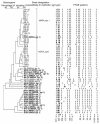Staphylococcus aureus isolates with reduced susceptibility to glycopeptides belong to accessory gene regulator group I or II
- PMID: 14982800
- PMCID: PMC353095
- DOI: 10.1128/AAC.48.3.1024-1027.2004
Staphylococcus aureus isolates with reduced susceptibility to glycopeptides belong to accessory gene regulator group I or II
Abstract
We used multiplex PCR to determine the agr group membership of 18 European glycopeptide heterointermediate and intermediate-resistant Staphylococcus aureus strains. Of the 15 agr group I strains, 13 were resistant and 2 were susceptible to methicillin. The remaining three strains, like the United States and Japanese control strains, belonged to agr group II.
Figures

References
-
- Bierbaum, G., K. Fuchs, W. Lenz, C. Szekat, and H. G. Sahl. 1999. Presence of Staphylococcus aureus with reduced susceptibility to vancomycin in Germany. Eur. J. Clin. Microbiol. Infect. Dis. 18:691-696. - PubMed
-
- Bobin-Dubreux, S., M. E. Reverdy, C. Nervi, M. Rougier, A. Bolmstrom, F. Vandenesch, and J. Etienne. 2001. Clinical isolate of vancomycin-heterointermediate Staphylococcus aureus susceptible to methicillin and in vitro selection of a vancomycin-resistant derivative. Antimicrob. Agents Chemother. 45:349-352. - PMC - PubMed
-
- Centers for Disease Control and Prevention. 2000. Staphylococcus aureus with reduced susceptibility to vancomycin—Illinois, 1999. Morb. Mortal. Wkly. Rep. 48:1165-1167. - PubMed
-
- Centers for Disease Control and Prevention. 1997. Staphylococcus aureus with reduced susceptibility to vancomycin—United States, 1997. Morb. Mortal. Wkly. Rep. 46:765-766. - PubMed
-
- Chang, S., D. M. Sievert, J. C. Hageman, M. L. Boulton, F. C. Tenover, F. P. Downes, S. Shah, J. T. Rudrik, G. R. Pupp, W. J. Brown, D. Cardo, and S. K. Fridkin. 2003. Infection with vancomycin-resistant Staphylococcus aureus containing the vanA resistance gene. N. Engl. J. Med. 348:1342-1347. - PubMed
MeSH terms
Substances
LinkOut - more resources
Full Text Sources
Medical

